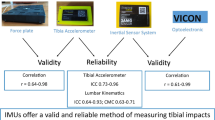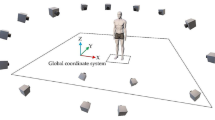Abstract
Magneto-inertial measurement unit (MIMU) systems allow calculation of simple sensor-to-sensor Euler angles, though this process does not address sensor-to-segment alignment, which is important for deriving meaningful MIMU-based kinematics. Functional sensor-to-segment calibrations have improved concurrent validity for elbow and knee angle measurements but have not yet been comprehensively investigated for trunk or sport-specific movements. This study aimed to determine the influence of MIMU functional calibration on thorax and lumbar joint angles during uni-planar and multi-planar, sport-specific tasks. It was hypothesised that functionally calibrating segment axes prior to angle decomposition would produce smaller differences than a non-functional method when both approaches were compared with concurrently collected 3D retro-reflective derived angles. Movements of 10 fast-medium cricket bowlers were simultaneously recorded by MIMUs and retro-reflective motion capture. Joint angles derived from four different segment definitions were compared, with three incorporating functionally defined axes. Statistical parametric mapping and root mean squared differences (RMSD) quantified measurement differences one-dimensionally and zero-dimensionally, respectively. Statistical parametric mapping found no significant differences between MIMU and retro-reflective data for any method across bowling and uni-planar trunk movements. The RMSDs for the functionally calibrated methods and non-functional method were not significantly different. Functional segment calibration may be unnecessary for MIMU-based measurement of thorax and lumbar joint angles.
Graphical abstract




Similar content being viewed by others
References
Bayne H, Elliott B, Campbell A, Alderson J (2016) Lumbar load in adolescent fast bowlers: a prospective injury study. J Sci Med Sport 19:117–122. https://doi.org/10.1016/j.jsams.2015.02.011
Bergamini E, Guillon P, Camomilla V, Pillet H, Skalli W, Cappozzo A (2013) Trunk inclination estimate during the sprint start using an inertial measurement unit: a validation study. J Appl Biomech 29:622–627. https://doi.org/10.1016/j.proeng.2013.07.073
Brice SM, Hurley M, Phillips EJ (2018) Use of inertial measurement units for measuring torso and pelvis orientation, and shoulder–pelvis separation angle in the discus throw. Int J Sports Sci Coach. https://doi.org/10.1177/1747954118778664
Broyden CG (1967) Quasi-Newton methods and their application to function minimisation. Math Comput 21:368–381. https://doi.org/10.2307/2003239
Burnett AF, Barrett CJ, Marshall RN, Elliott BC, Day RE (1998) Three-dimensional measurement of lumbar spine kinematics for fast bowlers in cricket. Clin Biomech 13:574–583. https://doi.org/10.1016/S0268-0033(98)00026-6
Camomilla V, Bergamini E, Fantozzi S, Vannozzi G (2018) Trends supporting the in-field use of wearable inertial sensors for sport performance evaluation: a systematic review. Sensors 18:1–50. https://doi.org/10.3390/s18030873
Chardonnens J, Favre J, Aminian K (2012) An effortless procedure to align the local frame of an inertial measurement unit to the local frame of another motion capture system. J Biomech 45:2297–2300. https://doi.org/10.1016/j.jbiomech.2012.06.009
Cole GK, Nigg BM, Ronsky JL, Yeadon MR (1993) Application of the joint coordinate system to three-dimensional joint attitude and movement representation: a standardization proposal. J Biomech Eng 115:344–349. https://doi.org/10.1115/1.2895496
Cutti AG, Ferrari A, Garofalo P, Raggi M, Cappello A, Ferrari A (2010) “Outwalk”: a protocol for clinical gait analysis based on inertial and magnetic sensors. Med Biol Eng Compu 48:17–25. https://doi.org/10.1007/s11517-009-0545-x
Dabirrahmani D, Hogg M (2017) Modification of the Grood and Suntay Joint Coordinate System equations for knee joint flexion. Med Eng Phys 39:113–116. https://doi.org/10.1016/j.medengphy.2016.10.006
de Vries WHK, Veeger HEJ, Cutti AG, Baten C, van der Helm FCT (2010) Functionally interpretable local coordinate systems for the upper extremity using inertial & magnetic measurement systems. J Biomech 43:1983–1988. https://doi.org/10.1016/j.jbiomech.2010.03.007
Favre J, Aissaoui R, Jolles BM, de Guise JA, Aminian K (2009) Functional calibration procedure for 3D knee joint angle description using inertial sensors. J Biomech 42:2330–2335. https://doi.org/10.1016/j.jbiomech.2009.06.025
Ferdinands RED, Kersting U, Marshall RN (2009) Three-dimensional lumbar segment kinetics of fast bowling in cricket. J Biomech 42:1616–1621. https://doi.org/10.1016/j.jbiomech.2009.04.035
Godwin A, Agnew M, Stevenson J (2009) Accuracy of inertial motion sensors in static, quasistatic, and complex dynamic motion. J Biomech Eng. https://doi.org/10.1115/14000109
Grood ES, Suntay WJ (1983) A joint coordinate system for the clinical description of three-dimensional motions: application to the knee. J Biomech Eng 105:136–144. https://doi.org/10.1115/1.3138397
Kalman RE (1960) A new approach to linear filtering and prediction problems. J Basic Eng 82:35–45. https://doi.org/10.1115/1.3662552
Ligorio G, Zanotto D, Sabatini AM, Agrawal SK (2017) A novel functional calibration method for real-time elbow joint angles estimation with magnetic-inertial sensors. J Biomech 54:106–110. https://doi.org/10.1016/j.jbiomech.2017.01.024
Mjøsund HL, Boyle E, Kjaer P, Mieritz RM, Skallgård T, Kent P (2017) Clinically acceptable agreement between the ViMove wireless motion sensor system and the Vicon motion capture system when measuring lumbar region inclination motion in the sagittal and coronal planes. BMC Musculoskelet Disord. https://doi.org/10.1186/s12891-017-1489-1
Najafi B, Lee-Eng J, Wrobel JS, Goebel R (2015) Estimation of Center of Mass Trajectory using Wearable Sensors during Golf Swing. J Sports Sci Med 14:354–363
O’Donovan KJ, Kamnik R, O’Keeffe DT, Lyons GM (2007) An inertial and magnetic sensor based technique for joint angle measurement. J Biomech 40:2604–2611. https://doi.org/10.1016/j.jbiomech.2006.12.010
Park FC, Martin BJ (1994) Robot sensor calibration: solving AX = AB on the Euclidean Group. IEEE Trans Robot Autom 10:717–721
Pataky TC (2018) spm1d [Website]. URL http://www.spm1d.org/ (accessed 8.1.19).
Pataky TC, Robinson MA, Vanrenterghem J (2013) Vector field statistical analysis of kinematic and force trajectories. J Biomech 46:2394–2401. https://doi.org/10.1016/j.jbiomech.2013.07.031
Picerno P (2017) 25 years of lower limb joint kinematics by using inertial and magnetic sensors: a review of methodological approaches. Gait Posture 51:239–246. https://doi.org/10.1016/j.gaitpost.2016.11.008
Picerno P, Cereatti A, Cappozzo A (2008) Joint kinematics estimate using wearable inertial and magnetic sensing modules. Gait Posture 28:588–595. https://doi.org/10.1016/j.gaitpost.2008.04.003
Theobald PS, Jones MD, Williams JM (2012) Do inertial sensors represent a viable method to reliably measure cervical spine range of motion? Man Ther 17:92–96. https://doi.org/10.1016/j.math.2011.06.007
Wells D, Alderson J, Camomilla V, Donnelly C, Elliott B, Cereatti A (2018) Elbow joint kinematics during cricket bowling using magneto-inertial sensors: A feasibility study. J Sports Sci. https://doi.org/10.1080/02640414.2018.1512845
Winter D (1990) Biomechanics and motor control of human movement, 4th edn. John Wiley & Sons, New York
Wong WY, Wong MS (2008) Trunk posture monitoring with inertial sensors. Eur Spine J 17:743–753. https://doi.org/10.1007/s00586-008-0586-0
Wu G, Siegler S, Allard P, Kirtley C, Leardini A, Rosenbaum D, Whittle M, D’Lima DD, Cristofolini L, Witte H, Schmid O, Stokes I (2002) ISB recommendation on definitions of joint coordinate system of various joints for the reporting of human joint motion—part I: ankle, hip, and spine. J Biomech 35:543–548. https://doi.org/10.1016/S0021-9290(01)00222-6
Wu G, van der Helm FCT, Veeger HEJ, Makhsous M, Van Roy P, Anglin C, Nagels J, Karduna AR, McQuade K, Wang X, Werner FW, Buchholz B (2005) ISB recommendation on definitions of joint coordinate systems of various joints for the reporting of human joint motion - Part II: Shoulder, elbow, wrist and hand. J Biomech 38:981–992. https://doi.org/10.1016/j.jbiomech.2004.05.042
Zhang Y, Chen K, Yi J (2013) Rider trunk and bicycle pose estimation with fusion of force/inertial sensors. IEEE Trans Biomed Eng 60:2541–2551. https://doi.org/10.1109/TBME.2013.2260339
Zhang Y, Chen K, Yi J, Liu T, Pan Q (2015) Whole-Body Pose Estimation in human bicycle riding using a small set of wearable sensors. IEEE/ASME Trans Mechatron 21:163–174. https://doi.org/10.1109/TMECH.2015.2490118
Acknowledgements
The authors would like to acknowledge Steven Kosovich and Jay-Shian Tan for their assistance with data collection.
Author information
Authors and Affiliations
Corresponding author
Ethics declarations
Conflict of interest
The authors declare no competing interests.
Additional information
Publisher's Note
Springer Nature remains neutral with regard to jurisdictional claims in published maps and institutional affiliations.
Supplementary Information
Below is the link to the electronic supplementary material.
Rights and permissions
About this article
Cite this article
Cottam, D.S., Campbell, A.C., Davey, P.C. et al. Functional calibration does not improve the concurrent validity of magneto-inertial wearable sensor-based thorax and lumbar angle measurements when compared with retro-reflective motion capture. Med Biol Eng Comput 59, 2253–2262 (2021). https://doi.org/10.1007/s11517-021-02440-9
Received:
Accepted:
Published:
Issue Date:
DOI: https://doi.org/10.1007/s11517-021-02440-9




